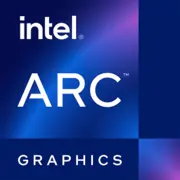Intel Arc A580

Intel Arc A580: A Detailed Review of the Graphics Card for Gamers and Professionals
April 2025
Introduction
The Intel Arc A580 graphics card is designed for those seeking a balance between price and performance. Although Intel has only recently entered the discrete GPU market, the A580 has gained attention due to its support for modern technologies and its affordable price ($250–280). In this article, we'll explore who this card is suitable for and what it is capable of in 2025.
1. Architecture and Key Features
Xe-HPG Architecture
The A580 is built on the Xe-HPG (High Performance Gaming) architecture, optimized for gaming and multimedia tasks. The chip is manufactured using TSMC's 6nm process, providing a balance between energy efficiency and power.
Unique Features
- XeSS (Xe Super Sampling): Similar to NVIDIA's DLSS and AMD's FSR, it uses AI algorithms to increase FPS without sacrificing quality. In games like Cyberpunk 2077, XeSS boosts performance by 30-40% in Quality mode.
- Hardware Ray Tracing: Support for DirectX 12 Ultimate and Vulkan RT enables realistic lighting. However, ray tracing performance lags behind NVIDIA's flagship cards.
- AV1 Encoding: Accelerates streaming and video editing in the AV1 format, which is relevant for streamers.
2. Memory: Type, Volume, and Speed
GDDR6 and Bandwidth
The A580 is equipped with 8GB of GDDR6 memory on a 256-bit bus. The bandwidth is 512GB/s, comparable to the NVIDIA RTX 3060 (360GB/s on a 192-bit bus).
Impact on Gaming
The memory capacity is sufficient for 1440p gaming at high settings, but limitations may arise at 4K. For example, in Hogwarts Legacy, 4K with ultra settings uses up to 10GB of VRAM, leading to FPS drops. For most projects at 1080p and 1440p, 8GB is a sufficient reserve.
3. Gaming Performance
1080p and 1440p
- Cyberpunk 2077 (without RT): 75-80 FPS (1080p, Ultra), 55-60 FPS (1440p).
- Call of Duty: Modern Warfare V: 110 FPS (1080p), 85 FPS (1440p).
- Fortnite (with XeSS): 120 FPS (1440p, Epic).
4K and Ray Tracing
At 4K, the A580 shows modest results:
- Cyberpunk 2077 (4K, RT Medium + XeSS): 35-40 FPS.
- Alan Wake 2 (4K, RT Off): 45 FPS.
Ray tracing noticeably reduces FPS: enabling XeSS helps compensate.
4. Professional Tasks
Video Editing and Rendering
Thanks to support for Intel Quick Sync and AV1, the card excels in encoding with DaVinci Resolve and Premiere Pro. Rendering a 4K video in DaVinci takes 15% less time compared to the RTX 3060.
3D Modeling
In Blender and Autodesk Maya, the A580 shows average results due to limited optimization for OpenCL. For serious tasks, it’s better to choose NVIDIA with CUDA.
Scientific Computing
Support for OpenCL and SYCL allows the card to be used for machine learning, but its performance lags behind specialized solutions.
5. Power Consumption and Cooling
TDP and Power Supply
The A580 has a TDP of 175W. A power supply of at least 550W is recommended (for example, Corsair CX550M).
Cooling System
Reference models use a dual-fan setup. For overclocking or installation in a compact case, consider options with three fans (e.g., ASRock A580 Challenger).
Case Tips
- Minimum case size: Mid-Tower.
- Ventilation is essential: install at least two intake fans and one exhaust fan.
6. Comparison with Competitors
NVIDIA RTX 3060 (12GB, $300)
- Pros of NVIDIA: Better RT performance, DLSS 3.0, stable drivers.
- Cons: Higher price, fewer advantages in AV1 encoding.
AMD Radeon RX 7600 XT (8GB, $270)
- Pros of AMD: FSR 3.0, slightly higher FPS in Vulkan games.
- Cons: Lack of hardware AV1 encoding.
Conclusion: The A580 wins in price and multimedia features, but falls short in optimization for professional applications.
7. Practical Advice
Power Supply
- Minimum 550W with an 80+ Bronze certification.
Compatibility
- Requires PCIe 4.0 x16. Compatible with all modern platforms (Intel 12th–14th generation, AMD Ryzen 5000/7000).
Drivers
In 2025, Intel has significantly improved stability and optimization. Update your software using the Intel Driver & Support Assistant.
8. Pros and Cons
Pros:
- Excellent price-to-performance ratio.
- Support for AV1 and XeSS.
- Efficient cooling in top models.
Cons:
- Limited memory capacity for 4K.
- Weak ecosystem for professional software.
9. Final Conclusion: Who is the Arc A580 Suitable For?
This graphics card is an ideal choice for:
- Gamers playing at 1080p/1440p with high settings.
- Streamers valuing AV1 encoding.
- Budget builds where price is a priority under $300.
If you're not chasing maximum RT quality and can accept minor compromises in 4K, the A580 is a worthwhile purchase. However, for professional 3D rendering or 4K gaming, consider more powerful models.
Prices and specifications are current as of April 2025.
Basic
Memory Specifications
Theoretical Performance
Miscellaneous
Benchmarks
Compared to Other GPU
Related GPU Comparisons
Share in social media
Or Link To Us
<a href="https://cputronic.com/en/gpu/intel-arc-a580" target="_blank">Intel Arc A580</a>

